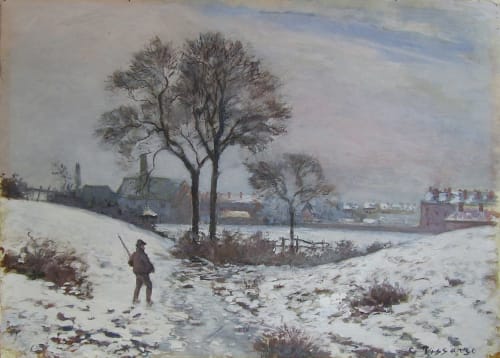Born on the island of St Thomas, in what were then the Danish Virgin Islands, Camille Pissarro was largely self-taught. His acquaintance around 1850 with a Danish artist, Fritz Melbye, convinced him of his true vocation. Between 1852 and 1854 they travelled together to Venezuela and for a year had a studio in Caracas. Two features of these early years are important as regards Pissarro’s later development: direct confrontation with nature under tropical conditions (in particular his attention to the effects of natural light) and close observation of peasant life.
Pissarro had attended school in Passy, outside Paris, between 1842 and 1847, and he returned to Paris itself in October 1855, at the same time as the Exposition Universelle. This provided him with an immediate opportunity to broaden his artistic horizons. He attended private classes at the Ecole des Beaux-Arts in 1856, and in 1861 he registered as a copyist in the Musée du Louvre. At the Académie Suisse, which he attended from about 1859, he met Cézanne, Monet and Armand Guillaumin, and his first submissions to the Salon date from this time. His works were accepted for exhibition almost every year until 1870. Although he kept a studio in Paris, Pissarro preferred to live in more rural places, such as Montmorency, La Roche-Guyon, Varenne-Saint-Maur, Louveciennes and Pontoise, where he lived from 1866 to 1868 and again from 1872 to 1882. Around 1860 Pissarro formed a liaison with Julie Vellay, a vine-grower’s daughter from Burgundy who worked for the Pissarro family. They had eight children between the years 1863 and 1884 and were married in London in 1871.
He was the only painter to exhibit in all eight of the Impressionist exhibitions held between 1874 and 1886, and he is often regarded as the father of the Impressionist movement. He was by no means narrow in outlook, however, and throughout his life remained as radical in artistic matters as he was in politics. Thadée Natanson wrote in 1948: ‘Nothing of novelty or of excellence appeared that Pissarro had not been among the first, if not the very first, to discern and to defend.’ The significance of Pissarro’s work is in the balance maintained between tradition and the avant-garde. Octave Mirbeau commented: ‘M. Camille Pissarro has shown himself to be a revolutionary by renewing the art of painting in a purely working sense; at the same time he has remained a purely classical artist in his love for exalted generalizations, his passion for nature and his respect for worthwhile traditions.’

